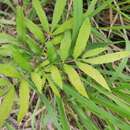fi
nimet breadcrumb-navigoinnissa


Mahonia fortunei is a species of shrubs in the family Berberidaceae, the barberry family, described as a species in 1846.[2][3] It is endemic to China, found in the provinces of Chongqing, Guangxi, Guizhou, Hubei, Hunan, Jiangxi, Sichuan, Taiwan, and Zhejiang.[1][4] It is grown as an ornamental in many lands, with common names including Chinese mahonia, Fortune's mahonia, and holly grape.[5]
Some authorities place the genus Mahonia in Berberis because there is no definite morphological distinction between the two genera. The subject awaits in-depth genetic analysis.[6]
This is an evergreen shrub that usually grows up to 2 meters tall, but sometimes reaches 4 meters. It is upright, spreading, and somewhat rounded. It has a slow to moderate rate of growth and a moderate density. The leaves are odd-pinnately compound and alternately arranged.[7] They are dull to dark green on top and pale yellowish green on the undersides. The blades measure up to 28 centimeters long by 18 wide. The foliage is borne in bunches at the stem tips. The inflorescence is a raceme with 4 to 10 fascicles of yellow flowers.[4] The flowers have a sweet scent and are insect-pollinated.[7] The fruit is a rounded purple-blue berry about half a centimeter long.[4] The fruit is edible and acidic in flavor but it has numerous seeds. It can be eaten cooked or raw and contains a good amount of vitamin C.[7]
This and many other related species contain the alkaloid berberine,[8] a chemical being studied for its therapeutic potential.[9]
This species is widely cultivated in China and in other places, such as Indonesia, Japan, and United States.[4]
This species is grown as an ornamental plant in gardens. It has multicolored leaves and yellow flowers. The fruits attract birds. It does not tend to have pests, and it is heat-tolerant.[7]
It makes an adequate hedge and it can be confined to a container for use as a houseplant.[5]
Mahonia fortunei is a species of shrubs in the family Berberidaceae, the barberry family, described as a species in 1846. It is endemic to China, found in the provinces of Chongqing, Guangxi, Guizhou, Hubei, Hunan, Jiangxi, Sichuan, Taiwan, and Zhejiang. It is grown as an ornamental in many lands, with common names including Chinese mahonia, Fortune's mahonia, and holly grape.
Some authorities place the genus Mahonia in Berberis because there is no definite morphological distinction between the two genera. The subject awaits in-depth genetic analysis.
Kayu ni adalah spesies tumbuhan yang tergolong ke dalam famili Berberidaceae.
Divisi : Spermatophyta
Sub divisi : Angiospermae
Kelas : Dicotyledonae
Bangsa : Ranunculales
Suku : Berberidaceae
Jenis : Mahonia fortunei
Pohon, tinggi 1-5 m.
Batang : Berkayu, kuning, tegak, bulat, bercabang-cabang, putih kotor.
Daun : Majemuk, menyirip ganjil, berpelepah pendek, anak daun sembilan Sampai lima belas lanset, ujung meruncing, tepi berombak dan berduri, panjang 11 cm, lebar 2-31/2cm, pertulangan menjari, hijau muda, hijau.
Kayu ni adalah spesies tumbuhan yang tergolong ke dalam famili Berberidaceae.
十大功劳(学名:Mahonia fortunei)别名:狭叶十大功劳、细叶十大功劳、福氏十大功勞、功勞木、木黃蓮、竹葉黃蓮鐵八卦、西風竹、貓兒頭、山黃連、土黃連、黃天竹,是小檗科十大功劳属的植物。
常绿灌木。奇数羽状复叶,狭披针形小叶,缘齿多;夏季开黄色花,总状花序下垂;蓝黑色浆果,有白粉。
分布在美国、日本、印度尼西亚、台灣以及中国大陆的广西、湖北、江西、四川、浙江、贵州等地,见于灌丛中、山坡沟谷林中、路边及河边,在长江流域广为栽培,华北地区也有少量引进栽培。
耐阴,也较耐寒,喜温暖湿润气候及肥沃湿润排水良好之土壤,耐旱,对土壤要求不严,在酸性,中性土壤中均能生长。[1]
 分類(APG III) 界 : 植物界 Plantae 階級なし : 被子植物 angiosperms 階級なし : 真正双子葉類 eudicots 目 : キンポウゲ目 Ranunculales 科 : メギ科 Berberidaceae 亜科 : メギ亜科 Berberidoideae 連 : メギ連 Berberideae 亜連 : Berberidinae 属 : メギ属 Berberis 種 : ホソバヒイラギナンテン
分類(APG III) 界 : 植物界 Plantae 階級なし : 被子植物 angiosperms 階級なし : 真正双子葉類 eudicots 目 : キンポウゲ目 Ranunculales 科 : メギ科 Berberidaceae 亜科 : メギ亜科 Berberidoideae 連 : メギ連 Berberideae 亜連 : Berberidinae 属 : メギ属 Berberis 種 : ホソバヒイラギナンテンホソバヒイラギナンテン(細葉柊南天、学名: Berberis fortunei)は、メギ科メギ属の常緑低木。
小葉はヒイラギナンテンよりも細長く、冬にも色づかない[2]。